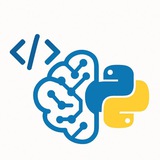@CodeProgrammer Matplotlib.pdf
4.3 MB
The Complete Visual Guide for Data Enthusiasts
Matplotlib is a powerful Python library for data visualization, essential not only for acing job interviews but also for building a solid foundation in analytical thinking and data storytelling.
This step-by-step tutorial guide walks learners through everything from the basics to advanced techniques in Matplotlib. It also includes a curated collection of the most frequently asked Matplotlib-related interview questions, making it an ideal resource for both beginners and experienced professionals.
#Matplotlib #DataVisualization #Python #DataScience #InterviewPrep #Analytics #TechCareer #LearnToCode
https://t.me/addlist/0f6vfFbEMdAwODBk
Please open Telegram to view this post
VIEW IN TELEGRAM
👍12❤2💯1
Introduction to Machine Learning” by Alex Smola and S.V.N.
Vishwanathan is a foundational textbook that offers a comprehensive and mathematically rigorous introduction to core concepts in machine learning. The book covers key topics including supervised and unsupervised learning, kernels, graphical models, optimization techniques, and large-scale learning. It balances theory and practical application, making it ideal for graduate students, researchers, and professionals aiming to deepen their understanding of machine learning fundamentals and algorithmic principles.
PDF:
https://alex.smola.org/drafts/thebook.pdf
Vishwanathan is a foundational textbook that offers a comprehensive and mathematically rigorous introduction to core concepts in machine learning. The book covers key topics including supervised and unsupervised learning, kernels, graphical models, optimization techniques, and large-scale learning. It balances theory and practical application, making it ideal for graduate students, researchers, and professionals aiming to deepen their understanding of machine learning fundamentals and algorithmic principles.
PDF:
https://alex.smola.org/drafts/thebook.pdf
#MachineLearning #AI #DataScience #MLAlgorithms #DeepLearning #MathForML #MLTheory #MLResearch #AlexSmola #SVNVishwanathan
👍4❤1
Machine Learning Notes 📝 (1).pdf
4.9 MB
Machine Learning Notes with Real Project and Amazing discussion
https://t.me/CodeProgrammer🌟
#MachineLearning #AI #DataScience #MLAlgorithms #DeepLearning
https://t.me/CodeProgrammer
Please open Telegram to view this post
VIEW IN TELEGRAM
👍6💯4
9 machine learning concepts for ML engineers!
(explained as visually as possible)
Here's a recap of several visual summaries posted in the Daily Dose of Data Science newsletter.
1️⃣ 4 strategies for Multi-GPU Training.
- Training at scale? Learn these strategies to maximize efficiency and minimize model training time.
- Read here: https://lnkd.in/gmXF_PgZ
2️⃣ 4 ways to test models in production
- While testing a model in production might sound risky, ML teams do it all the time, and it isn’t that complicated.
- Implemented here: https://lnkd.in/g33mASMM
3️⃣ Training & inference time complexity of 10 ML algorithms
Understanding the run time of ML algorithms is important because it helps you:
- Build a core understanding of an algorithm.
- Understand the data-specific conditions to use the algorithm
- Read here: https://lnkd.in/gKJwJ__m
4️⃣ Regression & Classification Loss Functions.
- Get a quick overview of the most important loss functions and when to use them.
- Read here: https://lnkd.in/gzFPBh-H
5️⃣ Transfer Learning, Fine-tuning, Multitask Learning, and Federated Learning.
- The holy grail of advanced learning paradigms, explained visually.
- Learn about them here: https://lnkd.in/g2hm8TMT
6️⃣ 15 Pandas to Polars to SQL to PySpark Translations.
- The visual will help you build familiarity with four popular frameworks for data analysis and processing.
- Read here: https://lnkd.in/gP-cqjND
7️⃣ 11 most important plots in data science
- A must-have visual guide to interpret and communicate your data effectively.
- Explained here: https://lnkd.in/geMt98tF
8️⃣ 11 types of variables in a dataset
Understand and categorize dataset variables for better feature engineering.
- Explained here: https://lnkd.in/gQxMhb_p
9️⃣ NumPy cheat sheet for data scientists
- The ultimate cheat sheet for fast, efficient numerical computing in Python.
- Read here: https://lnkd.in/gbF7cJJE
🔗 Our Telegram channels: https://t.me/addlist/0f6vfFbEMdAwODBk
📱 Our WhatsApp channel: https://whatsapp.com/channel/0029VaC7Weq29753hpcggW2A
(explained as visually as possible)
Here's a recap of several visual summaries posted in the Daily Dose of Data Science newsletter.
- Training at scale? Learn these strategies to maximize efficiency and minimize model training time.
- Read here: https://lnkd.in/gmXF_PgZ
- While testing a model in production might sound risky, ML teams do it all the time, and it isn’t that complicated.
- Implemented here: https://lnkd.in/g33mASMM
Understanding the run time of ML algorithms is important because it helps you:
- Build a core understanding of an algorithm.
- Understand the data-specific conditions to use the algorithm
- Read here: https://lnkd.in/gKJwJ__m
- Get a quick overview of the most important loss functions and when to use them.
- Read here: https://lnkd.in/gzFPBh-H
- The holy grail of advanced learning paradigms, explained visually.
- Learn about them here: https://lnkd.in/g2hm8TMT
- The visual will help you build familiarity with four popular frameworks for data analysis and processing.
- Read here: https://lnkd.in/gP-cqjND
- A must-have visual guide to interpret and communicate your data effectively.
- Explained here: https://lnkd.in/geMt98tF
Understand and categorize dataset variables for better feature engineering.
- Explained here: https://lnkd.in/gQxMhb_p
- The ultimate cheat sheet for fast, efficient numerical computing in Python.
- Read here: https://lnkd.in/gbF7cJJE
#MachineLearning #DataScience #MLEngineering #DeepLearning #AI #MLOps #BigData #Python #NumPy #Pandas #Visualization
Please open Telegram to view this post
VIEW IN TELEGRAM
❤11👍8💯1
from SQL to pandas.pdf
1.3 MB
#DataScience #SQL #pandas #InterviewPrep #Python #DataAnalysis #CareerGrowth #TechTips #Analytics
Please open Telegram to view this post
VIEW IN TELEGRAM
👍14❤1
